DEAR FRIENDS
Read about the newly formed Quarry Farm Foundation, a 501(3)(c) corporation created to ensure the long-term success of Quarry Farm and the Center for Mark Twain Studies
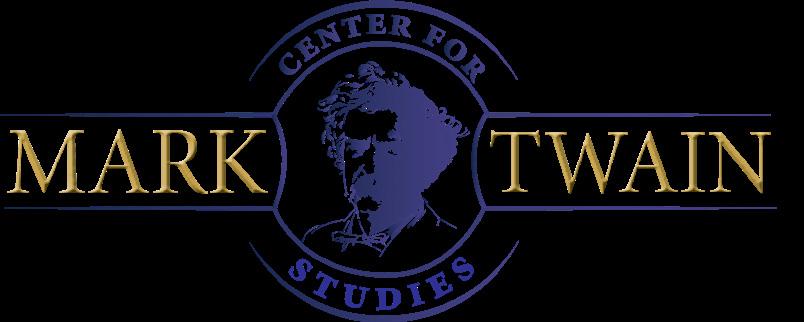

33

2022 CMTS
YEAR IN REVIEW
2022 PROGRAMs
staff
DR. JOSEPH LEMAK Director
ANN WELLES
Assistant Director
STEVE WEBB
Quarry Farm Caretaker
DR. MATT SEYBOLD
Associate Professor of American Literature & Mark Twain Studies, Elmira College
DR. CHARLES MITCHELL
Professor of American History, Elmira College
Contact
One Park Place, Elmira, NY 14901 607.735.1941
twaincenter@elmira.edu
Facebook: @marktwainstudies
Instagram: @centerformarktwainstudies
CMTS
The Elmira College Center for Mark Twain Studies was founded on December 31, 1982 with the gift of Quarry Farm to Elmira College by the Langdon family, Mark Twain’s in-laws. CMTS offers distinctive programs to foster and support Mark Twain scholarship and to strengthen the teaching of Mark Twain at all academic levels. CMTS serves the Elmira College community and regional, national, and international students and scholars of Mark Twain.
The beloved porch at Quarry Farm now features newly aquired, historically relevant furniture
2 2022 ANNUAL REVIEW WWW.MARKTWAINSTUDIES.ORG Contents PEOPLE 5 From the Director 8 CMTS Awardees 10 2022 Fellows 34 Supporters
6 Quadrennial Conference 22 Quarry Farm Sypmposium 24 Trouble Begins Lecture Series 3,4,14,32 Student Art Competition Winners 39 Clemens and the Pen 40 Elmira College Mountain Day NEWS 26 Medical Milk at Quarry Farm 28 Taking Care, Steve Webb 30 Communique from Scholar, Matt Seybold 33 Quarry Farm Foundation, Carl T. Hayden OPPORTUNITIES 36 Call for Papers 38 2024 Fellowship Guidelines ON
COVER
THE
Quintel Clements ‘22
Honorable Mention
PORTRAYING MARK TWAIN
ART COMPETITION 2022

3
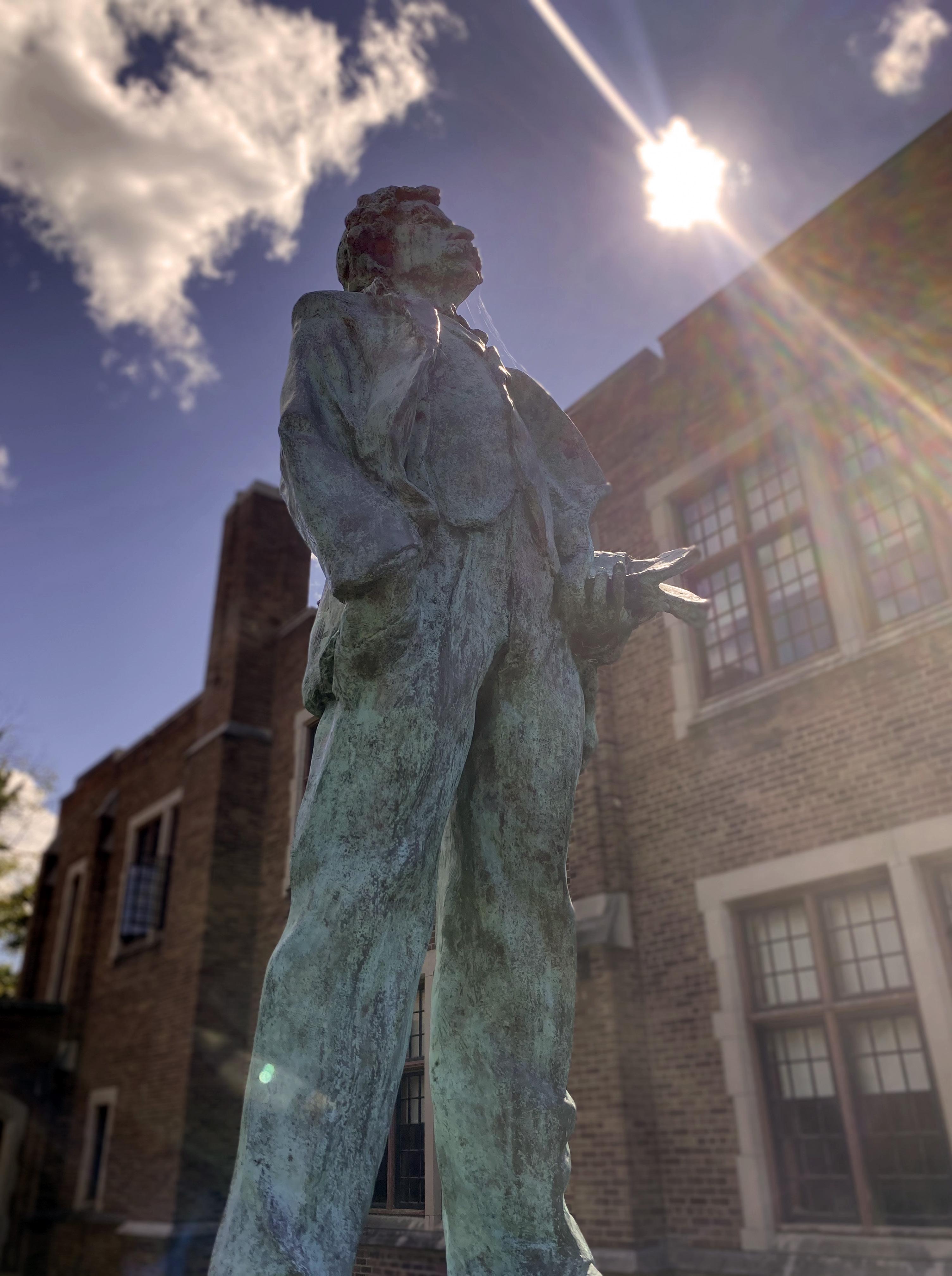
4
FROM THE DIRECTOR
2024 will be the 150th anniversary of the Mark Twain Study.
Dear Friend,
On June 11, 1874, while summering at Quarry Farm in Elmira, Mark Twain wrote a letter to his good friend Joseph Twichell. The author was reveling in a surprise gift from his sister-in-law, Susan Crane:
Susie Crane has built the loveliest study for me, you ever saw. It is octagonal, with a peaked roof, each octagon filled with a spacious window, & it sits perched in complete isolation on top of an elevation that commands leagues of valley & city & retreating ranges of distant blue hills. It is a cozy nest, with just room in it for a sofa & a table & three or four chair - & when the storms sweep down the remote valley & the lightning flashes above the hills beyond, & the rain beats upon the roof over my head, imagine the luxury of it!
Mark Twain proceeds to write some of the most important and iconic works of American literature in this small structure, including The Adventures of Tom Sawyer, Adventures of Huckleberry Finn, A Connecticut Yankee in King Arthur’s Court, and numerous other full-length books, short stories, letters, speeches, and a couple bawdy plays.
2024 will be the 150th anniversary of the Mark Twain Study. In preparation for the upcoming celebrations, the Center for Mark Twain Studies is busy making sure the landmark structure is in peak condition for the sesquicentennial events. In 2023 our goal is to restore all the windows and make them fully operational, along with other important preservation and restoration projects to mark the anniversary.
Please consider giving this year to the Center for Mark Twain Studies. Your gift will not only help us preserve the Study, but it also helps us sustain all of our good works – the Quarry Farm Fellowship Program, the CMTS academic conferences and symposia, literary outreach to students and teachers, creation of content on MarkTwainStudies.org, the Trouble Begins public lecture series, and the careful stewardship of CMTS’ other literary landmark – Quarry Farm. As a token of our appreciation, you will receive mailings announcing upcoming events and our occasional newsletter, Dear Friends, describing the activities of the Center for Mark Twain Studies.
Thank you so much for your kind support and encouragement through the years. If you happen to be in Elmira, we would be happy to show you how your gift benefits the Study, Quarry Farm, and the Mark Twain Studies community.
With sincere gratitude,
 Carina Gibbs ‘23
Joseph Lemak Director
Carina Gibbs ‘23
Joseph Lemak Director
5
Left:
PORTRAYING MARK TWAIN ART
2022
First Prize
COMPETITION
The Ninth International Conference on the State of Mark Twain Studies:
2022 Quadrennial Conference
Established in 1989, the Center for Mark Twain Studies “International Conference on the State of Mark Twain Studies” is the oldest and largest gathering devoted to all things Twain. During times so turbulent and uncertain as to require that the quadrennial conference on the State of Mark Twain Studies be postponed by a year, the theme of change and growth “speaks to our condition,” as the Quakers say.
The conference was held from Thursday, August 4 to Saturday, August 6, 2022 on the campus of Elmira College in Elmira, New York. An important focus of the conference was scholarly discussion of the study of Mark Twain and how the field might grow and change in response to changing conditions in the world, in the academy, and in the field of Mark Twain Studies.
In addition to over 50 individual paper presentations and 7 roundtable events, the conference provided contexts for Mark Twain and his life in Elmira, and also featured a keynote by Jimmy Santiago Baca, an awardwinning writer for whom Twain has been an important influence. Mr. Baca’s keynote was titled “A Sense of Twain.”
Conference attendees also had the opportunity to attend a special multi-media presentation by two nationally-known and respected television critics David Bianculli (NPR’s Fresh Air with Terry Gross, Rowan University, and www. TVWorthWatching.com) and Mark Dawidziak (recently retired from Cleveland’s Plain Dealer and Kent State University). They examinined a number of portrayals of Mark Twain on both the big and small screen with humor and wit in “All The Twain’s Meet: The Film and TV Portrayals.”
Learn more about the Quadrennial Conference on MarkTwainStudies.org.
6
Use QR code for link to complete conference program
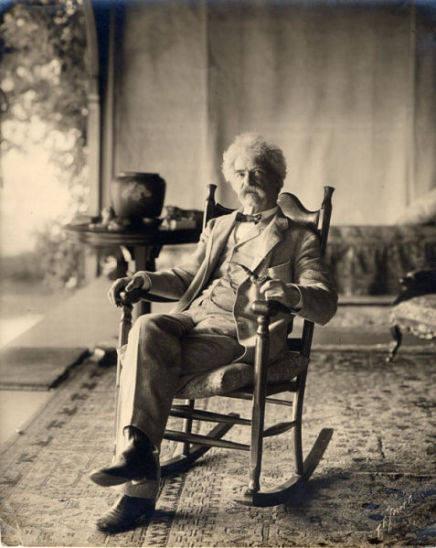
7
Mark Twain seated in a rocking chair on the porch at Quarry Farm, East Hill, Elmira New York, 1903
QR code to see a list of Quadrennial Conference presenters, click on name for recorded lecture
“What is the most rigorous law of our being? Growth.”
Mark Twain, from “Consistency,” a paper read in Hartford in 1887 Use
CMTS Awards:
Jervis Langdon Jr Award, Elise Johnson-Schmidt
During Elmira 2022: The Ninth International Conference on the State of Mark Twain Studies, CMTS presented a series of awards, including two for service to CMTS including the inaugural Jervis Langdon Jr. Award for members of the local or regional community who “further Langdon Jr.’s vision,” first articulated in 1982, to preserve Quarry Farm as a retreat for scholars studying Twain’s life, work, legacy, circle, and world.
The inaugural Jervis Langdon Jr. Award was given to Elise Johnson-Schmidt of Johnson-Schmidt & Associates, Preservation Architects. JohnsonSchmidt and her team have been essential to the ongoing preservation of Quarry Farm and the Mark Twain Study. As Director Joseph Lemak put it during the awards presentation,“There is no one who knows Quarry Farm better than Elise. She is the principal author of the Quarry Farm Historic Structures Report…She is responsible for organizing and prioritizing almost all of our preservation projects, most importantly fire suppression and water drainage surrounding the main house. She and her team have designed gutter systems, drainage systems, and the new bookshelves on the second floor She has helped us pick out new and older pieces of furniture for everyday use. She used her interior decoration skills to help us redesign the second floor She has consulted with us on specific colors, wallpapers, plants, rugs, and curtains. Our newest project completion is the acquisition of the 1920’s old hickory furniture on the porch, which has transformed the space, not only to improve its historical accuracy but to increase its function as a workspace, both important strategic goals. This is just a small sample of her work at Quarry Farm.”
The Henry Nash Smith Award, is named for the original director of the Mark Twain Project and given to a member of the broader Twain Studies scholarly community who has made special contributions to CMTS’s goals during the years immediately preceding the conference.


The Henry Nash Smith Award for Service was presented to Lawrence (Larry) Howe, Emeritus Professor from Roosevelt University. Foremost, during his term as President of the Mark Twain Circle of America, Howe prioritized and formalized collaboration between CMTS and MTC, an effort which has helped the two organizations create new initiatives and co-sponsor new programs, marshaling the collective resources to serve Twain Studies more effectively. Some of the near-term fruit of such collaboration include “From Seminar Paper to Publishable Article: A Workshop for Graduate Students and Recent PhDs”, two special issues of Mark Twain Annual based on Quarry Farm Symposia, and the Mark Twain Circle Series here at MarkTwainStudies.org.
Moreover, Howe co-organized the 2018 Quarry Fam Symposium “American Literary History and Economic in the Gilded Age,” contributed to three more symposia, consulted on strategic planning documents, and wrote several online essays, including the very popular “Black Lives Matter at Quarry Farm.” And even beyond these formal service contributions, as Dr. Lemak put it, Howe consistently delivers “simply good fellowship” and is “a positive force,” even “pitching in” unprovoked to set up for events. “This means something,” Lemak said, “to Steve [Webb] and myself.”
8
Henry Nash Smith Award, Lawrence Howe
John S. Tuckey Awards for Lifetime Achievement
Susan K. Harris

Bruce Mickleson

“Both recipients of this year’s Tuckey Award began publishing their first peer-reviewed work in Twain Studies during the 1980s. In each case, their first publication appeared in a now defunct academic journal. It’s hard to believe that the Dutch Quarterly Review of Anglo-American Letters couldn’t make a go of it in the digital era.
Both scholars made major book-length contributions to Twain Studies within a few months of one another during what I think is now quite recognizable as a paradigm shift in Twain Studies, which took place between 1993 and 1998. During this period, much of the conventional wisdom of midcentury started being questioned, notably the artificial severance of Twain’s humor from his politics and the misogynist yada-yadaing of his domestic life. This is also when Elmira resurfaces in Twain Studies, both as a site of production, but also a recognized influence on his life and writing. Between them, tonight’s awardees have given ten Trouble Begins lectures, dating back to the Fall 1988 series, all but one of which you can listen to in our digital archive.
During the mid-’90s, Twain Studies was, for the first time, casting back upon its own critical canon and finding it be narrow, conservative, and sometimes flatly inaccurate. Each of tonight’s recipients contributed to the revisions of this period, and seem to have been incited to go even further, in opposite temporal directions, towards applying the methods of new historicism and postcolonialism to portions of Twain’s life and writing which were ignored through the entirety of the 20th century. Each wrote a book in the first decade of the 21st Century without which the current field becomes hard to imagine. During the morning flash sessions on Thursday, two words kept coming up to describe how Twain is interpolated into the contemporary: imperialism and technology. These scholars are largely responsible for making us think that.
But this does not adequately capture their lifetime achievement, as each has also held numerous service roles, as officers, editors, board members, and organizers for The Mark Twain Circle, Mark Twain Annual, The American Humor Studies Association, The Center For Mark Twain Studies, our sister Twain sites, and others. And in these roles, I can personally testify, I have seen them do the yeoman work of scholarship: recruiting, mentoring, refereeing, corresponding. In this respect, their mark is left on nearly every member of this audience. Regardless of how much of their scholarship you have read, they have probably read yours.
And so, it is my great pleasure, to present the sixth and seventh John S. Tuckey Awards for Lifetime Achievements in Mark Twain Studies to Susan K. Harris and Bruce Michelson.”
9
From Matt Seybold’s presentation of the awards at the 9th International Conference on the State of Mark Twain Studies.
2022 Quarry Farm
Fellows
Sponsored by Simon Evnine, University of Miami
Elizabeth Cantalamessa is a PhD candidate in philosophy at the University of Miami whose research lies at the intersection of social philosophy, philosophy of language, and philosophical methodology. Her dissertation proposes an alternative model of humor as a methodological tool with unique expressive powers that allows speakers to publicly demonstrate sociallysignificant values without explicit justification, which explains why humor serves as a tool for political critique. She has published in The British Journal of Aesthetics, Inquiry: An Interdisciplinary Journal of Philosophy, as well as the online public philosophy outlets Aeon, Psyche, and Aesthetics for Birds.
“My dissertation project is largely inspired by a passage from Mark Twain’s unfinished work The Mysterious Stranger where the devil contends that the human race has only one truly effective weapon against the lies of the powerful: laughter. Though Twain often espoused a misanthropic attitude, he understood that humanity’s fundamental flaws had to be acknowledged rather than ignored, and humor allowed him to communicate ethical criticisms indirectly, without implying that he was referring to or ridiculing anyone in particular. I argue that Twain’s ironic portrayals caused his audiences to reconsider what they otherwise assumed to be natural or unproblematic and so served as a method for ethical instruction. I want to relate
the claim that humor is an instructional method to Twain’s condemnation of “brickbat culture” which equates education with processes of passive memorization and encourages students to value knowledge as the feeling of security, rather than as a never-ending form of active inquiry. I think Twain can serve as a model for a more humanist and sentimentalist form of political instruction, and as a template for how we should use humor as an instrument for rehabilitating our current political challenges and divisions. Another aspect of my project will be establishing Twain as a philosopher whose methodological commitments place him in the pragmatist tradition alongside Friedrich Nietzsche and Ludwig Wittgenstein.”
During her time in Elmira, Cantalamessa delved into the archives to better understand the historical figures that inspired Mark Twain, his self-conception as a humorist, and his remarks on the limits of traditional “straightfaced” political deliberation.

10
Elizabeth Cantalamessa
Sponsored by Maurice S. Lee, Boston University
Max Laitman Chapnick is a PhD candidate in American and English literature at Boston University. He is working on a dissertation called “Wild Science: Radical Politics and Rejected Knowledge in NineteenthCentury Fiction” interested in the fields of novel studies, the history of social movements, and the history of science. He earned an MA in Creative Writing from Victoria University of Wellington on a Fulbright scholarship. His essays appear in Configurations, Current Affairs, and PMLA.
At Quarry Farm, he worked on the section of his dissertation focusing on three late-nineteenth-century time travel narratives: Edward Bellamy’s Looking Backward (1888), Mark Twain’s Connecticut Yankee in King Arthur’s Court (1889), and H. G. Wells’s Time Machine (1895). The three authors emerge from a broad field of “scientific socialists,” yet in each narrative an anti-scientific element remains; Wells shows evolutionary theories unraveling; Bellamy’s “quack” mesmerism remains necessary for imagining communism, and Twain’s techno-state turns dramatically into a militarized wasteland, a premonition

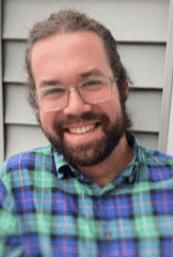
for the first World War. For Twain in particular, even as he would later express a fraught relationship to rejected knowledges like Christian Science, his relationship to science was fraught as well. These three technologyminded dys/utopic time travel narratives ask: what if the increasing consolidation of science into a disciplinary and elitist project, and its uptake as an engine of state, empire, and war, undermined science’s more populist promise?
In the context of Twain’s later interest and disdain for pseudo-science as in Christian Science (1907) and his critique of imperial projects as in King Leopold’s Soliloquy (1905), Chapnick investigated to what extent that engagement with science and empire, and the relationship between those two, began in earlier decades during the writing of Connecticut Yankee.
Cassio de Oliveira
Sponsored by John MacKay, Yale University Cassio de Oliveira is an assistant professor of Russian in the Department of World Languages and Literatures at Portland State University. His articles, primarily on Sovietera Russian literature and film as well as in Translation Studies, have appeared or are forthcoming from Russian Literature, The Slavic and East European Journal, Canadian Slavonic Papers, Slavonica, Tolstoy Studies Journal, Studies in Slavic Cultures, KinoKultura, and other journals. He recently completed his first monograph, entitled Writing Rogues: The Soviet Picaresque and Identity Formation, 1921–1938. De Oliveira is currently conducting research for his second
monograph, Mark Twain’s Mississippi Writings in the Russian Imagination, which focuses on the reception, translation, and adaptations of Mark Twain’s works in Russia. In telling the history of Twain in Russia, de Oliveira concentrates on the Soviet period, when Twain came to be seen both as a prime representative of world literature, and as a staunch critic of bourgeois society and American imperialism. De Oliveira completed his B.A. at Bard College and received his Ph.D. from Yale University. At Portland State, he teaches courses in Russian language and literature, European Studies for the general education program, as well as a seminar in Translation Studies.
“In my book, entitled Mark Twain’s Mississippi Writings in the Russian Imagination, I investigate how and why Mark Twain acquired canonical status in the Soviet Union amidst debates of literary merit and the ideological import of literature. My project examines the multifaceted reception of Twain’s works as entertainment, edification, and engaged literature.
11
Max Chapnick
I show that, from the late Tsarist period through the collapse of the Soviet Union one century later, Mark Twain’s works, especially Tom Sawyer and Huckleberry Finn, enjoyed immense popularity with Russian readers and underwent multiple adaptations to the stage and the screen. The novels became classics of children’s literature that resonated with critics and readers in their evocation of a carefree childhood (in Tom Sawyer) and exploration of a dark yet idyllic isolation from society (in Huckleberry Finn). The novels also struck a note in the early Soviet literary environment, when adventure narratives and popular genres were seen as a means to rejuvenate Russian literature along communist principles. Moreover, the Soviets read Twain’s Mississippi writings as documents of antebellum life – a combination of the intrepid and industrious spirit of the common American man, and of the social devastation inflicted by the
institution of slavery. The novels thus provided fodder for ideological critiques of capitalism that drew attention to the institution of slavery and persistent radical inequality in America. Mark Twain’s Mississippi Writings in the Russian Imagination explains how Twain, seen through Soviet eyes, went from being an American humorist to a staunch critic of America; from a representative of American mores to a singer of the universal experience of childhood.”
At Quarry Farm, de Oliveira researced Twain’s connections with Russia and to start drafting Chapter One of the book, which focuses on Twain’s visit to Russia in 1867 (recounted in The Innocents Abroad) and on the Russian reception of his works before the October 1917 Revolution.
Sponsored by Kerry Driscoll, The Mark Twain Papers & Project, University of California, Berkeley
The Mark Twain House & Museum’s Director of Collections Jodi DeBruyne and Assistant Curator


Malory Howard
Mallory Howard share the responsibility for the care, exhibition, and interpretation of the Mark Twain House and the museum’s collection of more than 20,000 artifacts and documents. Howard has aided countless researchers, done important work herself on Twainian subjects, and has spoken on aspects of Twain’s life and work in venues ranging from scholarly conferences to Mississippi riverboats. She earned her B.A.in American History at Central Connecticut State University and was inducted into the national history honor society Phi Alpha Theta. She holds a certification from the Modern Archives Institute in Washington, D.C. DeBruyne has worked at museums across the country including the Chrysler Museum in Norfolk, VA, the City Museum in Juneau, AK, and the Abbe Museum in Bar Harbor, ME. She earned her B.A. in Art History at Old Dominion University and her M.A. in Museum Studies from Johns Hopkins University.
Jodi DeBruyne
Jodi DeBruyne and Mallory Howard will be conducting research and drafting exhibition text for the Mark Twain House & Museum’s upcoming 2023 exhibit on Summering with Twain. The exhibition will use the experiences of Samuel Clemens and his family to illustrate and examine the development of an iconic element of American culture, which continues to play a major role in our society today – the summer vacation. The exhibition will educate visitors through an engaging and accessible format about Mark Twain and aspects of his life, his work, and his era, while also allowing them to make connections to their lives today and causing them to reflect on the still relevant themes that will be explored – including the impact of class, gender and race on lifestyle, health, and access to leisure activities. The exhibit will explore many locations visited by Sam Clemens and his family while on their summer holidays., but a large section of the exhibit will be dedicated to the more than twenty summers they spent with Livy’s family at Quarry Farm and it is their time in Elmira that was the focus of DeBruyne and Howard’s fellowship.
Read Mallory Howard’s Testamonial - Page 20
12
Jennifer Hughes
Sponsored by Tracy Wuster, University of Texas, Austin Jennifer A. Hughes is Associate Professor of English and Chair of the Department of Language, Literature, and Culture at Averett University where she teaches courses in American literature, including an honors course on American humor and satire. She served as the Secretary/ Treasurer of the American Humor Studies Association from 2013-2018 and has held fellowships from the American Antiquarian Society and the Andrew W. Mellon Foundation. Her essays have appeared in Studies in American Humor, Southern Frontier Humor: New Approaches, The Southern Literary Journal, The Journal of Graphic Novels and Comics, A Concise Companion to American Fiction 1900-1950, and African American Review.

While visiting Quarry Farm, she researched Mark Twain’s awareness of late nineteenth-century laws and trials concerning libel, censorship, and freedom of religion. Mark Twain weighed legal and social risks to himself and his loved ones while drafting the Mysterious Stranger manuscripts (“The Chronicle of Young Satan,” “Schoolhouse Hill,” and “No. 44, the Mysterious Stranger”). In his notebooks, Mark Twain expresses vague concerns about publishing controversial texts at the turn of the century — “books that laugh at the whole paltry scheme” – because he was responsible for the well-being of his family. He would have been aware of international trials in which texts played a role in ruining careers and lives. For example, Oscar Wilde was put to trial in 1895 and eventually sentenced to two years in jail for the “gross indecency” of homosexuality. The prosecution used Wilde’s writings, and his jokes, as evidence against him. In 1898, Emile Zola published “J’accuse,” knowing that he would be tried for libel in exposing the corrupt anti-Semitism of the French government in the Dreyfus affair. This project considers the extent to which Mark Twain felt similarly endangered, and the degree to which his concerns influenced writings that present laughter as an utterance that testifies against the absurd immorality of humanity.

13
“Great books are weighed and measured by their style and matter, and not by the trimmings and shading of their grammer.”
Mark Twain, 1887 “General Grant’s Grammer”
Sponsored by Priscilla Wald, Duke University Bill Hunt is an assistant professor at Barton College in Wilson, North Carolina, where he usually teaches WRT 101, WRT 102, ENG 201, ENG 231, and ENG 232. He specializes in 19th- and early-20th-century American literature, with interests in Gender and Women’s Studies, Post-/Colonialism Studies, Sentimentalism, Middle East Studies, and literatures of the U.S. Suffrage Movement. He has published articles in The Nathaniel Hawthorne Review and in an edited book collection, American and Muslim Worlds before 1900 (Eds. John Ghazvinian and Mitchell Fraas). He holds a B.A. and M.A. from the University of Virginia and a Ph.D. from Duke University.
His scholarship is often impelled by the notion that the American Suffrage Movement was essentially literary in character, as much as it was social and political. In 2017, he began a digital humanities experiment, www.100signersproject.com, a research blog that utilizes archival records to create recuperative biographies for the 100 individuals who lent their names to the Declaration of Sentiments at the Seneca Falls Convention.

“My project traces the competing parochial and transnational dimensions of Mark Twain’s conversion to the cause of women’s suffrage. These varying economies of scale play out in revealing ways in his 1879 short story “The Great Revolution in Pitcairn.” To address questions surrounding the global feasibility of women’s enfranchisement, Twain turns to the Lilliputian, South Pacific island of Pitcairn, the first sovereignty on earth to grant women the right to vote, doing so in 1838.

From his arrival in 1832 until being forcibly removed in 1837, one Joshua W. Hill fashioned himself as the de facto ruler of Pitcairn Island. In “The Great Revolution in Pitcairn,” Butterworth Stavely, Twain’s literary proxy for Hill, drives his newly minted empire swiftly to the brink of ecocidal and economic collapse. In this context,
suffrage appears to have been mustered into existence as an anti-colonial strategy, designed to protect the island’s population from future political usurpations. I am interested in how the narrative’s shifting attitudes toward universal franchise in “The Great Revolution in Pitcairn” speaks to related, seemingly inconsequential events that occurred in the borderlands of the Burnedover District during the same period.”
14
William Hunt
Sponsored by Simon Evnine, University of Miami Hester Kaplan is the author of two story collections, The Edge of Marriage, winner of the Flannery O’Connor Prize for Short Fiction, and Unravished, and the novels The Tell and Kinship Theory. Her fiction and nonfiction has been widely published and anthologized, including in The Best American Short Stories series. She is the recipient of a Creative Writing Fellowship from the National Endowment for the Arts for her current nonfiction project, How Mark Twain Helped Me Find My Father. She is on the faculty of Lesley University’s MFA Program in Creative Writing, and is a co-founder of Goat Hill Writers.
“My father, Justin Kaplan, famously wrote about Mark Twain. As an orphan and an intensely private man, his own life story was a mystery to me. “The question for a good biographer,” he wrote, “is not why, but how: how it felt for the subject of the biography to live his life.” In How Mark Twain Helped me Find My Father, I take up the question of how he became a biographer of Twain, how he spent his career uncovering the lives of others but would not reveal how he felt about his own, and how given his beginnings marked by profound loss, he found direction and meaning through writing. In my reading of his biography of Twain for the first time, I am also discovering the sources of his creative energy, and how I’ve come to write the biography of a biographer.
When my father wrote about Twain that “the central drama of his mature literary life was his discovery of the useable past,” did he know that his own past was usable? The orphan must write his own life story and become fiction writer, protagonist, and autobiographer at the same time. In writing about my father, I am fiction writer, protagonist, and biographer, striving to tell the story of a life that is both connected to and separate from my own.
“Most biographies are begun out of enchantment or affection,” Leon Edel wrote, and mine begins with both.”

Hester Kaplan

15
Left: Hannah Baxter ‘23
PORTRAYING MARK TWAIN ART COMPETITION 2022
Honorable Mention
Sponsor: Joseph Csicsila, Eastern Michigan University
Judith Yaross Lee is Distinguished Professor Emerita of Communication Studies at Ohio University, where she taught from 1990 to 2019. Her six books and five dozen articles on American popular rhetorics include Twain’s Brand: Humor in Contemporary American Culture (2012), Seeing MAD: Essays on MAD Magazine’s Humor and Legacy (2020), and “The Sociable Sam Clemens: Mark Twain Among Friends” (2018). She chaired the 2020 Quarry Farm Symposium, “American Humor and Matters of Empire,” based on her essay of the same name in Studies in American Humor. She is currently completing a study of Clemens’s 37-year relationship with the African explorer Henry Morton Stanley.


“My two-week Quarry Farm Fellowship in 2022 supported research and writing about how Mark Twain shaped the travel narratives of his visit to Australia and Tasmania—More Tramps Abroad and Following the Equator (1897)—from his experiential, textual, and ideological sources. My October-November 2017 travels in Clemens’s footsteps through the Adelaide and Glenelg areas of South Australia, Melbourne and the
Central Victorian mining district, and the Tasmanian coast have suggested how Clemens’s experience on the ground fed his published narratives about British settlement and indigenous life.”
Yaross Lee used her Quarry Farm residency to study key differences between the Clemens’s corrected typescript of the manuscript and the representation of his Australian and Tasmanian travels in both published editions, with an eye to understanding the rhetorical decisions that shaped Mark Twain’s public presentation of British colonization to his distinct audiences at home and in the empire in this important landmark in his growing anti-imperialism.
Sponsored by James E. Caron, University of Hawai’i, Mānoa Jeanne Campbell Reesman is Professor of English and Jack and Laura Richmond Endowed Faculty Fellow in American Literature at the University of Texas at San Antonio, which she joined in 1986. She has served as Division Director, MA and PhD Directors, as Graduate Dean, and, presently, on the Executive Committee of the UTSA Academy of Distinguished Scholars. She has been awarded two Fulbrights, one in Thessaloniki and the other in Aix-en-Provence. She is the author
of numerous books and essays on American writers, especially London and other Naturalists, Twain, James, and Faulkner. Her critical biography, Jack London’s Racial Lives, appeared in 2009, and her co-authored Jack London, Photographer appeared in 2010, both U of Georgia P. Her most recent book is Jack London in His Own Times, 2020, U of Iowa P. Her essays and book chapters have appeared in journals including the Mark Twain Annual, the Mark Twain Journal, American Literary Realism, and American Literary Naturalism Her current project is her book, Mark Twain vs. God: The Story of a Relationship.
“My forthcoming book, Mark Twain vs. God: The Story of a Relationship, under contract with the University of Georgia Press, needs to be finished and indeed come forth.
16
Jeanne Campbell Reesman
Judith Yaross Lee
The book demonstrates that Twain aims at God and belief in many settings. In some works he attacks hypocritical churchgoers and organized Christianity; in others he naturalistically surveys humanity and the false “spiritual” worlds men and women have created for themselves. His Defendant and Judge are the same: God Himself, not “religion.” He does not spare Americans’ most cherished institutions: first religion, but also banks, police, courts, Congress, clergy, the bourgeois class he married into, Sunday School, universities, U.S, Imperialism. He imagines medieval cultures against modernity. He seeks God behind Nature in the West and in the cities of the East. He travels with other “pilgrims” to the holy sites of Europe and Palestine. He tracks the Euro-American global imperialism of his age. But in more fantastic works his evolving understandings of the relationship between himself and God, and God and humanity take his readers from myth to reality to myth to
reality again—Eden and the Flood through the Civil War to the Gilded Age, and from dream-life to real-life and back again. His questions about the Creator’s intentions remain as provocative now as they were when he first penned them. Oddly, though Twain sometimes sounds like or outright says he is God’s agent here on Earth, he hated God more than anyone; he never used the kind of invective he reserves for the Almighty on anyone else. He is essentially outraged by the hoax or catch-22 God presents humanity. He made us as we are but damns us for it. Particularly troubling to Twain is the actual Creator’s indifference, coupled with the God of the Bible, who made us in His image but should not have admitted it; this split is clearest in Letters from the Earth.”
Sponsored by Joseph Csicsila, Eastern Michigan University
Ariel Silver is the author of The Book of Esther and the Typology of Female Transfiguration in American Literature (Rowman & Littlefield, 2018) and a contributor to Esther in America (Maggid, 2020). Her work on Margaret Fuller and May Alcott has just been published in The Forgotten Alcott (Routledge, 2021). She has written on Joan of Arc in the work of Hawthorne, Adams, and Twain for a RFEA special issue on Joan of Arc in America (2019) Her article on Twain’s Roughing It, “From Liverpool to the Lion House,” is forthcoming in the Mark Twain Journal. She currently serves as President-elect of the Hawthorne Society.

The purpose of her Quarry Farm Fellowship was to complete a chapter on Twain for a larger proposed monograph, The Literary Eve. The chapter on Twain –“There was Eden” – serves as a crucial point of transition in the project, moving from male to female authorial consideration of this iconic scriptural figure whose story has come to represent so fundamentally a conception of the female and her place across the monotheistic world. By placing Adam and Eve in the context of one another
Ariel Silver
in The Diaries of Adam and Eve, Twain suggests that their fortunes and their fates, their tribulations, and their joys, are inextricable. Written near the end of his life, in a period when he also produced Recollections of Joan of Arc, this work of religious commentary by Twain deftly combines the serious and the satirical to produce a wholly new view of Eve. Even as the historicalcritical method begins to be applied to the Bible, Twain comically attempts his own textual deconstruction and reconsideration of the Genesis text in a manner that gives space for a female voice and perspective, however funny, however ironic. This chapter then sets the stage for the American female writers who take up their own critique of how Eve has been cast and how she can and should be deeply reconsidered.
17
Sponsored by Joseph Lemak, Elmira College
Bridget Bossart van Otterloo paints and teaches in Corning, New York. Her artwork is about the beauty in nature. She has a degree in Studio Art from Houghton College and has studied in Florence, Italy. Bridget moved to Corning in 2002 to work as an apprentice and studio assistant for the late Thomas S. Buechner. She currently works from her light-filled home studio, where her subjects include still life, flowers, plants, portraits and landscapes painted in oils and watercolor. Bridget teaches painting workshops from her home studio. She has also has taught art classes at local youth centers, museums, libraries, Corning Community College, and public schools. Bridget has been on the faculty of 171 Cedar Arts Center teaching oil painting and watercolor painting classes since 2002. Bridget’s work can be viewed at several venues in New York State including The ARTS Council of the Southern Finger Lakes in Corning, The North Star Gallery in Ithaca, Memorial Art Gallery in Rochester, Oxford Gallery in Rochester, Gallery 54 in Skaneateles, and The Franklin Street Gallery in Watkins Glen.

Bossart van Otterloo created a series of landscape paintings in oil, as well as sketches in pencil and watercolor, “en plein air” – out in the open air. The grounds, buildings, and forest around Quarry Farm served as inspiration as did the preserved interiors and historical details.
 Below:
Below:
18
Watercolor painting by Bridget Bossart van Otterloo, with brushes
Bridget Bossart van Otterloo
Bridget Bossart van Otterloo: Quarry Farm Testamonial
I thoroughly enjoyed my week at Quarry Farm as an Artist in Residence. I could see why Mark Twain and his family loved it here, the view and breeze from the valley is heavenly. Over my five-day stay at Quarry Farm I completed five paintings, one painting a day! I set for myself this goal at the beginning of the week, and was happy to achieve it. My work feels like play (most of the time) and the right environment can help me stay in that flow state needed to create work.
Quarry Farm is an ideal place for inspired concentration. There is a peacefulness accompanied by bird song that made the perfect background for plein air painting.
What I enjoy about plein air painting is the time pressure and challenge of finishing a painting in about 4-5 hours. It forces me to loosen up, to not be too tight or get caught up in too many details. You have to stand back from your subject and think, what is most important here? What should I focus on, and what can be left out? Then you can only stand out on the lawn for so long with the flies sticking in your paint, and the spongy moth caterpillars parachuting down from the trees –you have to get right to the heart of the painting. When I wasn’t

painting, I enjoyed exploring the historic house, checking out all the books in the library and study, and walking around the grounds.
I spent most of my time out on the front porch painting and observing. The light was best here for painting, and the view was always inspiring.
Spending the week out on the porch and in the historic house made me feel like I was stepping back in time. I could imagine all the time Mark Twain, his family, and friends spent here. Susan Crane really achieved her goal of making Quarry Farm a place people wanted to be, enjoying their own company, and the company of others.
Above:
19
Oil painting by Bridget Bossart van Otterloo, in process at Quarry Farm
Bridget Bossart van Otterloo
Mallory Howard: Quarry Farm Testamonial
My first thought on receiving the fellowship was how honored and excited I was to experience two weeks at Quarry Farm: pouring through the bookshelves, rummaging through Mark Twain journals, sitting the regal space of the Twain archive at Elmira College. My second thought was how much I was looking forward to the cookie bar at Wegman’s. It really is the best.
Jodi and I are working on The Mark Twain House & Museum’s (Hartford, CT) 2023 exhibition on the Clemens family’s summers and the places where they spent them. We have narrowed these down to specific sites that are meaningful and important to them. Elmira is a no-brainer. They spent so many summers at Quarry Farm, enjoying the peaceful respite on top of the glorious East Hill.
As soon as we arrived, we dumped our luggage and ran out to the famous porch to take in that spectacular view. It’s hard to pull away from it, and even harder now that the Wi-Fi access extends that far. We know the master of description, Samuel Clemens, had the right words to describe the experience of watching day drift into evening:
Close by…we saw the intense blue of the skies, through rents in the cloud-rack, and away off in another quarter were drifting clouds of a delicate pink color. In one place hung a pall of dense black clouds, like compacted pitch-smoke. And the stupendous wagon wheel was still in the supremacy of its unspeakable grandeur. So you see, the colors present in the sky at once and the same time were blue, green, pink, black, and the vari-colored splendors of the rainbow.
Like Sam, we had fled the city of Hartford for quiet solace among nature: a place where we could escape the hectic buzz of life at the museum in order to focus and get to work. Unlike Sam, we weren’t lucky enough to sit perched atop the hill, a short walk from the Crane home, to work in an octagonal study covered with ivy. We were still able to find perfectly suited spots to set up shop and dig into our research. On warm days, we propped up our laptops and made the porch our outdoor office. On cold and rainy ones, I holed up in the beautiful library, surrounded on all sides by various tomes and paintings. Jodi set up in the kitchen with a cup of hot tea, sun streaming through the windows, on the lookout for our new furry friends Weezy, Greg, and Dr. Carmichael. I would be lying if I didn’t hope to hear Jodi alert me to a sighting, so I could drop what I was doing and take a much-needed cat break. I think Sam would have approved of this.
When we weren’t busy using the rich resources in the Crane home, we were off on research excursions to see what more we could find. We trekked to Ithaca to visit the archive at Cornell, looking over Ida Langdon’s papers, and letters from Frederick Douglass. We spent hours at the Park Church immersed in the importance of what the Langdons and
Beechers accomplished there. We left feeling inspired and more connected to those families than ever before. We were engrossed by the archive at the Gannett-Trip Library and the Chemung Historical Society. Every place we went during our fellowship we gained knowledge, insight, and inspiration, all key to the research and planning of an exhibition.
But it was more than that. It was delving into the history of this place and these people and letting them seep into us. I have been to Elmira many times; my first visit was in 2013 for the State of Mark Twain Studies conference. I remember being in complete awe of Quarry Farm, Woodlawn Cemetery, the octagonal study. They gave me chills.
Our Mark Twain House colleague Michael Campbell joined us for the weekend, an Elmira first-timer. Nine years after my first visit I watched him experience the same things I once did. We gently cleaned the lichen from Katy Leary’s grave, we trudged through Woodlawn for a seemingly interminable amount of time until we succeeded in locating John Lewis and Mary Ann Cord. We placed flowers at the graves of the Langdon and Clemens families. We stared up at the crooked, yet beautiful stone steps leading up to the original study site, and we climbed them. We stood at the top and we silently took in what standing there meant to us. We then cracked a few jokes, told a few stories, and took refuge back in the warmth of the home.
We knew before we arrived that the summers in Elmira meant to the Clemens family. But we learned so much more about the history of the town, the Park Church, John Lewis, Mary Ann Cord, the Langdons, the Cranes, the Beechers, and in our upcoming exhibition we want to tell those stories too. After two weeks of research, we left feeling fulfilled. We escaped our frenetic lives in Hartford in order to enjoy the tranquility and recreation Quarry Farm provided us. We also buckled down and got some damn work done. And isn’t that as it should be?
Mallory Howard
Samuel Clemens
P.S. Please give Dr. Carmichael our warmest regards, and a scratch or two
20
“What work I have done I have done because it has been play. If it had been work I shouldn’t have done it.”
Right: Dr. Carmichael taking in the view from the Quarry Farm Porch, photo courtesy of Mallory Howard

21
9th Annual Quarry Farm Symposium
Abolition Studies
Right: Program Art from the Ninth Quarry Farm Symposium by media artist Jan Kather, 2022
Talks available online:
The Ninth Quarry Farm Symposium “Abolition Studies” sought to take an intentional transhistorical approach to abolition studies through panels and discussions that attend to the Longue durée of abolitionist thought, activism, and organizing from the 19th to the 21st centuries. While there is robust scholarship on movements to abolish chattel slavery in the U.S. before 1865, and there is growing interest – both scholarly and popular – in late 20th- and 21st-century prison and police abolition. This symposium looked to explicitly bring these two historical epochs into conversation across what Saidya Hartman has called “the nonevent of emancipation” towards a richer analysis of, for example, carcerality, rights, social and civil death, enclosure, and criminalization. The symposium was especially interested in presentations that rigorously trouble the very notion of continuity, recognizing both the persistence of what Douglas A. Blackmon has called “slavery by another name” as well as the continuing “acts of resistance and sabotage” against racial terror and carceral capture identified by Sarah Haley and others occurring in the decades of transition from the late 19th to the early 20th century. That is, it invited analysis not only of forces of capture but also of resistance.
With this long history of mechanisms of captivity and modes of radical resistance in mind, the symposium emphasized the interconnecting relationship between abolitionist movements working against the enduring legacies of U.S. racism in carceral forms from the 19th to the 21st centuries. And in recognition of recent insightful work in the field of critical prison and carcerality studies by thinkers including Ruth Wilson Gilmore, Erica Meiners, Liat Ben-Moshe, Kelly Lytle Hernández, Harsha Walia, Savannah Shange, Luana Ross, Eric Stanley, and others, we seek to enrich understandings of how carceral logics and institutions develop and expand across time to iterate in ever greater spaces of both public and private life.
Use QR CODE for list of presenters. Click on presenter’s name to view available recordings.
Sarah Haley, “Gender and the Abolitionist Present” Keynote Address
Alex Alston, “Animal Afterlives: 19th Century Abolitionism & The Discourse of Species”
Margarita Lila Rosa, “Riotous Women, Criminalization, and the Voyeuristic Press in 1890s California”
LaVelle Ridley, “Imaginative Abolition, Political Life Writing, and Black Trans Feminist Blueprints”
remus jackson, “‘This is the kind of society I’m looking for, anyway’: Krysta Morningstarr & The Radical Potential of Prisoner’s Comics”
Srimayee Basu, “The Entanglements of Emancipation and Juvenile Discipline in the Early Black Prison Memoir”
Michelle-Velasquez-Potts, “Slow Death and the Domestication of Indefinite Detention”
Kia Turner & Darion Wallace, “Exploring Anti-Carceral Education: Towards Mapping and Historicizing Contemporary Educators’ Theory and Praxis in Abolitionist Terms”
Christopher Paul Harris, “The Last President: Notes on Abolition and the (un)Making of the World System”
Matt Seybold, “Mark Twain, The Abolitionist”
M. Cecilia Azar, “Liberating the Punchline: Abolitionist Practices in Running One Thousand Miles for Freedom“
Thomas Dichter, “Captivity and Abolition in Boarding School Literature: Between Elmira and Carlisle”
Cait N. Parker, “‘In Love, Devotion, and Continuous Struggle’: Revolutionary Lesbian Abolitionists, 1970s-1990s”
Henry Washington, Jr. “Criminalis Sequitur Ventrum: Post-Slavery Discipline’s Biological Myth of Origin”
22
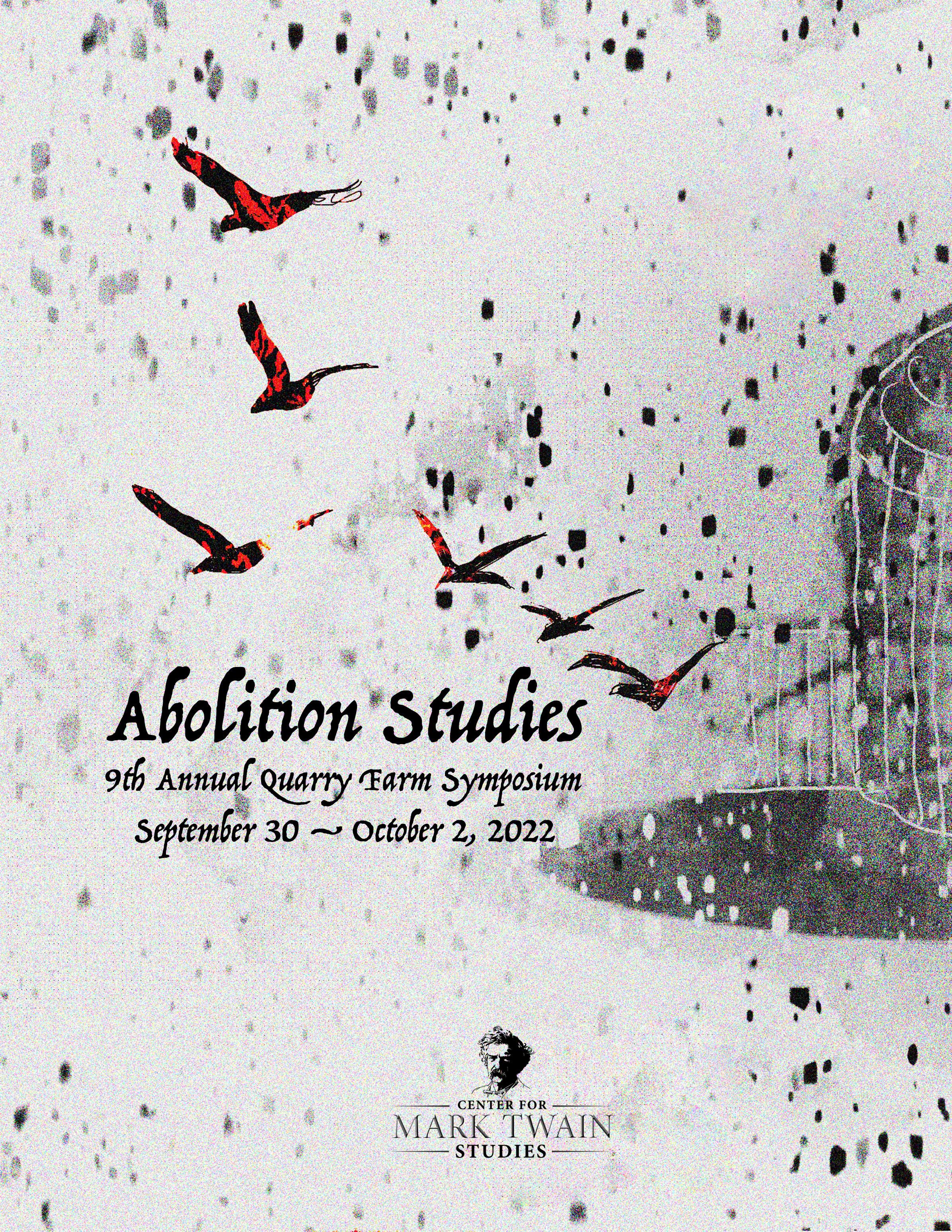
23
Trouble Begins
2022 Lecture Series
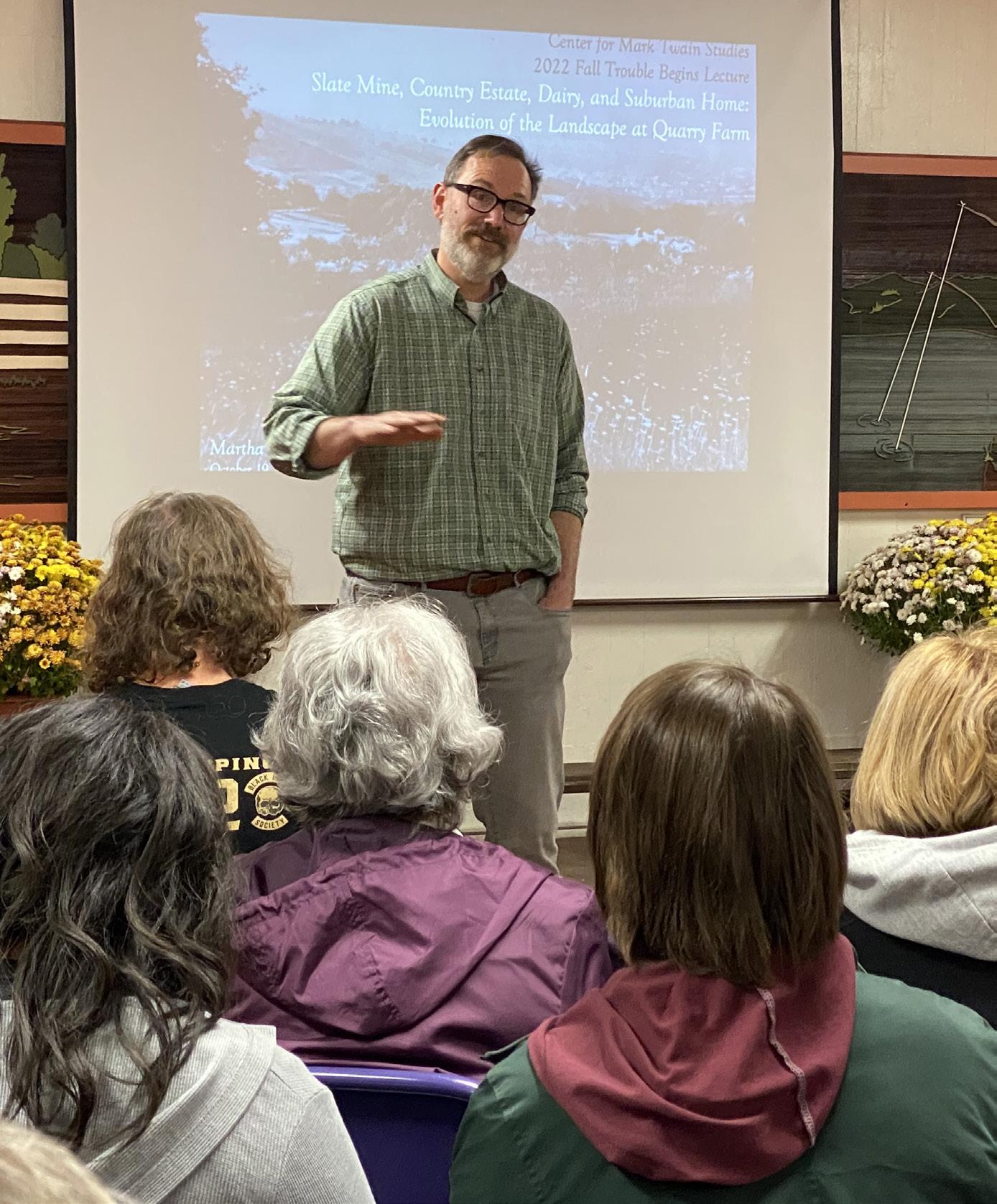
May 4
“Found in Translation: Mark Twain’s Italian Humor”
Fred L. Gardaphe, Queens College/CUNY, and the John D. Calandra Italian/American Institute
May 11
“A Yankee in Kennedy’s Court: The Humorous American Story and the Mark Twain Prize” Charline Jao, Cornell University
May 18
“A Copyright Ignored? Mark Twain, Mary Ann Cord, and the Meaning of Authorship”
Timothy J. McFarlin, Samford UniversityCumberland School of Law
May 25
“’Our One Really Effective Weapon’: Mark Twain and Humor as a Social Tool”
Elizabeth Cantalamessa, University of Miami
June 22
“’There was Eden’: Eve in the Time of Twain Ariel Silver, Author
July 6
“Twain’s Connecticut Yankee in PseudoScientific Socialist Utopias
Max Chapnick, Boston University
July 20
“Mutiny on the Ballot: Conversion Narrative in Mark Twain’s ‘The Great Revolution in Pitcairn”
Bill Hunt, Barton College
October 5
“’There is no humor in heaven’’: Mark Twain and Religious Liberalism
Dwayne Eutsey, Independent Scholar
October 12
“Haunted by the River”
Shirley Samuels, Cornell University
October 19
“Slate Mine, County Estate, Dairy, and Suburban Home: Evolution of the Landscape at Quarry Farm”
Martha Lyon, Principal of Martha Lyon Landscape Architecture, LLC
October 26
“Mr. Stanley, I Presume: Mark Twain’s 1872 Visit to England and His Growth as a Writer”
Judith Yaross Lee, Ohio University pellentesque.
24
CMTS’s annual Trouble Begins public lectures are presented in the Barn at Quarry Farm and Park Church in downtown Elmira.
Above: CMTS Director, Joseph Lemak introduces Martha Lyon of Martha Lyon Landscape Architecture, LLC
In 1985, the Elmira College Center for Mark Twain Studies inaugurated The Trouble Begins at Eight lecture series. The title comes from a handbill advertising Mark Twain’s October 2, 1866 lecture presented at Maguire’s Academy of Music in San Francisco.
Trouble Begins lectures are free and open to the public and available online
Below:
Above: Joe Slade and Judith Yaross Lee talking with lecture attendees
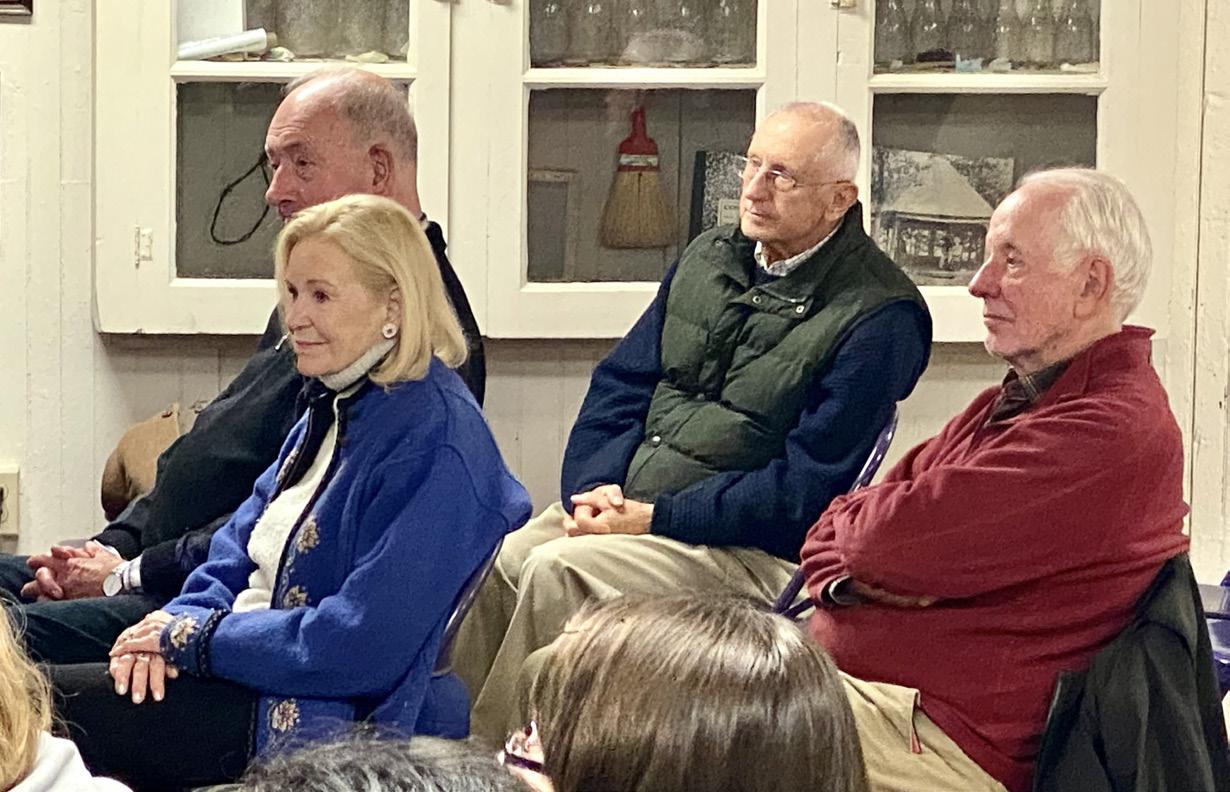

Below: A glimpse of Judith Yaross Lee’s laptop during her lecture, “Mr. Stanley, I Presume: Mark Twain’s 1872 Visit to England and His Growth as a Writer”
Trouble Begins lectures available online: Use the QR code for archives on marktwainstudies.org
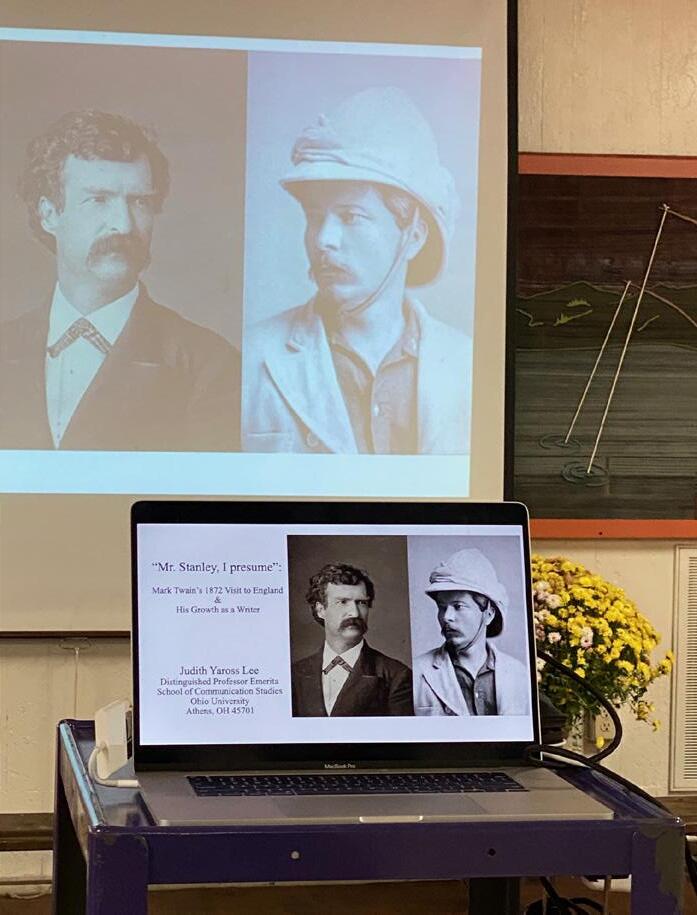
25
Attendees at a Trouble Begins Lecture in the Quarry Farm Barn


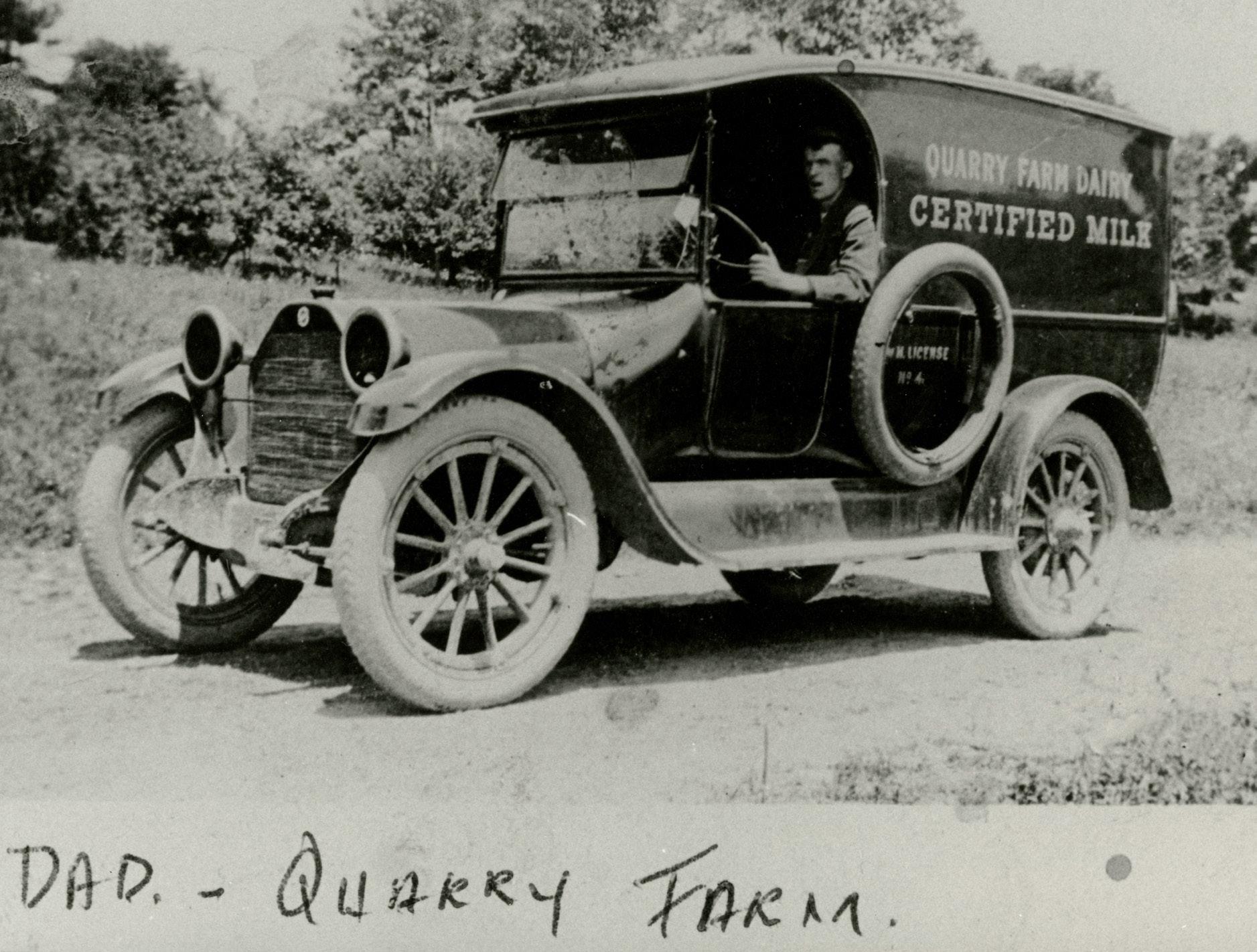
26
Right: Students discuss the new display at Quarry Farm before a Trouble Begins lecture.
Above: Milk Bottles, 19001925, excavated from a site on Quarry Farm
Left: Quarry Farm Milk Truck, Ca. 1920, photograph from Elmira College Archives with no record of who “Dad” was
during Trouble Begins lectures at Quarry Farm
Mark Pitner's HIS 2950 class recently completed a new display on 'Certified Milk' in the Barn at Quarry Farm. An unexpected topic, but one that illustrates that in addition to the creative output of the ‘father’ of American Literature, Samuel Clemens, aka Mark Twain, other meaningful endeavors took place at the Farm. Endeavors that not only give us a historical perspective but also enrich our understanding and appreciation of others who played pivotal roles at Quarry Farm and beyond.
The principal character in this story about dairy products is Susan Crane. Crane began running Quarry Farm in 1870 after her father, Jervis Langdon, who had purchased the property the prior year, died and willed the property to his eldest daughter and her husband. By all accounts, Susan Crane was the driving force behind much of what made Quarry Farm special, and she did so until she was 83. Her interest in safely storing and transporting milk products led her to become active in the American Association of Medical Milk Commissions. It is a credit not only to her business acumen but also to her interest in improving conditions for residents of the region.
Today we assume the milk we buy is safe. However, as the students discovered, this has not always been the case. In the latter half of the 19th century, there was a growing awareness of food safety. Forward-looking Susan Crane recognized the value of advancements in testing, refrigeration, and faster delivery via motorized vehicles. Quarry
Milk?

Farm became an early adopter of improved practices and was one of the first in the region to produce Certified Milk.
Mark Pitner says one well-composed photograph of a motorized vehicle, a milk truck with ‘Quarry Farm Dairy Certified Milk’ hand-lettered on the side, gave his students direction. "This image helped to anchor the class discussion and research in a physical world and urged us to understand the documentary evidence as speaking to a material reality. It of course left us with a range of questions such as who is “Dad”? What vintage of a truck is this? and so on. Some of these we were able to answer, some we were not. This is the nature of archival work.”
With such questions in mind, the students got to work on how to best fill the 8 x 2 foot display case. Working in teams, they did research, developed text, and selected images and artifacts. They combed through digital and physical archives and confronted the vagaries of cursive texts written in ink from nib-tipped pens.
From archives to exhibit, Jacob Casallas '22, Elizabeth Graham '24, Mitchell Haight '24, Victoria Lamphere '23, Sarah McGrain '23, Cassidy Ryan '24, and Jarod Signorelli '23 gained valuable experience from this unique project. Now visitors to Quarry Farm's barn will also benefit, gaining a new appreciation of Susan Crane and learning the story of Certified Milk.
Ann Welles
27
Got Certified
This new display is on view
Taking Care
Annual Quarry Farm Update from Steve Webb



It’s been another busy year here at Quarry Farm. Even though our event schedule was back in full swing, we were still able to complete several important projects to improve the house, the property, and the scholarly habitat so that all is properly preserved and made more conducive for inspirational insight and productivity. And while the Center for Mark Twain Studies staff has been running around like crazy, we wanted to make sure the scholars didn’t have to.
goes in the latter. We also commissioned local artists, Jennifer Thomas and Bridget Bossart Van Otterloo to paint their favorite parts of the landscape surrounding the farm. They both did an amazing job, creating two paintings each that are proudly displayed in the Scholar’s Lounge. With the new furniture, painting, paintings on the painting, and some healthy green ferns and parlor palms, the place has a whole new feel that is both elegant and fully functional.
One of our main focuses this year was to make the upstairs of the house, where scholars spend most of their time when they're not on the porch, more comfortable. I started by painting the three study areas early in the year. Then we purchased a new leather couch, and two big cozy chairs that make it a really comfortable place to get some reading done. You might be wondering, Steve, why didn't you use antique furniture since the house is a historic landmark? Well, the answer to that is simple: antique furniture is horribly uncomfortable. The house has some museum rooms and some living spaces. All the beautiful, old and uncomfortable furniture goes in the former, and all the beautiful, new and comfortable furniture
One of our most challenging projects of the year was the restoration of The Crane Bedroom. Although it’s not quite complete we are very, very close to wrapping it up. The original plan was to replace the 1950s wallpaper with something more period appropriate–a reproduction of a pattern from the late nineteenth century. But in contemplating the job we found that underneath the plaster was a decorative wall covering called Lincrusta. Lincrusta was popular in the late nineteenth century and is found throughout the house in different patterns. In uncovering this buried treasure we decided to rip out all the plaster and restore the Lincrusta to the best of our ability. It turned out to be a much more challenging task than originally anticipated, but we’ve weathered the proverbial storm, there’s light at the end of the tunnel, and we are set to wrap this project up in the near future.
Water, water everywhere but I can’t find the leak. In the world of historical preservation water is one of our most persistent adversaries. Can’t live with it, can't live without it. When we fix one leak I rarely have a moment of relief before another arises. The most recent round of Whack-A-Mole had the H2O seeping through
28
Right: Steve Webb, Quarry Farm Caretaker since 2013
Left: Weezy, Catahoula Leopard Dog and Quarry Farm hospitality expert
the bricks of our most western facing chimney and into the Twain Bedroom. Luckily, we have the historic stone mason Courtney DeRusha in our corner. She and her team erected an impressive scaffolding structure around the towering brick chimney and repointed and restored the whole thing over the course of a couple weeks this summer. It was a daunting task and she not only completed it to perfection but she fixed a crumbling section of the front porch while she was at it–since she had her tools out anyway.
On to the Parlor. The room of the house that is most like it was in Twain’s day. The kind of room where we keep the uncomfortable furniture. There were some bay windows in that room that were in terrible shape. They were ancient and dysfunctional and had the insulating qualities of swiss cheese. It just so happens that we know the guy that wrote the book on historic window restoration (literally.) Steve Jordan came to the rescue and restored the four windows to their original beauty. And it’s quite possible that they work better now than they did one hundred years ago. Nice work, Steve Jordan!
In other news about exceptional Steves, I, with the help of my assistant Jacob, painted almost the entire exterior of the house this year. In previous years we’d tackle one
side per summer but this year, we got in the zone and left no peeling paint unscraped, no bare wood uncovered, no exposed stucco left behind. We reached high peaks previously untouched by man and thwarted the efforts of even the most persistent carpenter bees. It was an unrivaled performance. The sense of accomplishment will be temporary though, I know, winter is harsh and paint’s gonna peel, but for the moment I will relish in this victory before I prepare to prepare for the next battle.
Our front porch received a major makeover this year too. With the help of Elise Johnson-Schmidt, we acquired some amazing Old Hickory furniture from the early 1900s that completely transformed the space. It was made at roughly the same time that this iteration of the porch was constructed so not only does it look beautiful but it fits historically as well. We added some ferns and other plants, the cherry on top, and the place is better than it’s been since the days of Susan Crane.

With all these accomplishments we still had time to plan for the future. There are several projects in the works for this winter and next summer. I don’t want to spoil next year's Dear Friends.
Below:
Steve Webb
29
Newly acquired Porch Furniture at Quarry Farm
Forward-minded
Communique from Resident Scholar Matt Seybold
This Fall I was invited to present at two events hosted by the Modern Language Association, a webinar on “Developing & Sustaining Projects in the Public Humanities” and a roundtable on “Literary Criticism: New Platforms.” The implication was clear: the Center For Mark Twain Studies is creating public-facing multimedia resources at the vanguard of the academic humanities. As the ecosystem of scholarship continues to change, we strive to emulate Twain’s spirit as a forward-minded media theorist and entrepreneur.
This year we produced four new seasons of The American Vandal Podcast, another digital edition of an underappreciated work in Twain Studies, and a blog collaboration with The Mark Twain Circle of America. We vastly expanded our archive of video lectures, launched a new critical series, and continued updating ongoing series like “The Apocryphal Twain,” “Quarry Farm Testimonials,” and “Twain For Teachers.” Once again, we set new records for web visitors, podcast downloads, and YouTube streams. We even launched a Mastodon instance in the Fediverse! (If you don’t know what that means, don’t worry about it.)
For the first time, I co-produced a podcast series with a guest host, Mika Turim-Nygren, winner of the inaugural Mark Twain Circle Emerging Scholar Award. In the three-episode arc of “Mark Twain Among The Indians,” Dr. Turim-Nygren speaks with reviewers of Kerry Driscoll’s landmark book, Native Studies scholars, and Dr. Driscoll herself. It is an outstanding pilot for what we hope will become a frequent feature of our podcast feed.
Other podcast series included “The World’s Work” (7 episodes on worker movements and labor politics from the 1880s to the present), “HBO: From Pulp To Prestige (6 episodes on the corporate history and genre categories associated with the network), and “Social Problems” (4 episodes on a chaotic year in social media). Each of these seasons featured special theme music from indie recording artists: Dan Reeder, The Snarlin’ Yarns, & Squirtgun.
By every metric, The American Vandal Podcast went to a new level in 2022. Subscriptions tripled and, according to Spotify, it was a top 10% most followed and most shared podcast in the world. Numerous episodes reached the Apple Podcast charts in the “Book” and “Arts” categories, and even the overall Top 200, in dozens of national markets, including the US, UK, and Canada.
Out biggest project of 2022 at MarkTwainStudies. org was the publication of a digital edition of Charles Neider’s Mark Twain & The Russians (1960). With rights generously donated by Susan M. Neider, we were able to create a thoroughly annotated edition of the “cultural exchange” between Neider, the preeminent midcentury editor of Twain’s works, and Yan Bereznitsky, a Soviet literary critic. Our edition also includes the Russian language version of the exchange, as it was originally published in Literaturnaya Gazeta and other primary sources.

30
Inspired by the publication of Mark Twain & The Russians I began a new series, “The Twain Doctrine,” focused on tracking the use (and abuse) of Twain’s legacy and likeness during the Cold War. Two installments have been published thus far, on squabbles over Twain surrounding the 1959 American Exhibition in Moscow and the 1960 State Department tour of Hal Holbrook’s Mark Twain Tonight!. More installments will be coming, along with much more, in 2023.


Thank you for your continued support of MarkTwainStudies. org, The American Vandal, and the Center For Mark Twain Studies!
Matt Seybold
Use QR code for American Vandal podcasts available on marktwainstudies.org
31

32
“Our interest lies in the long term viability of Quarry Farm as a Cultural Humanities Site and its use as an inspiration...”
Alex Taylor ‘23
Honorable Mention PORTRAYING MARK TWAIN
ART COMPETITION 2022
QUaRRY FARM FOUndation Letter from Carl Hayden, President:
Dear Friend:
My name is Carl Hayden. I have been in the thrall of Quarry Farm from the first day I set foot in this lovely little town.* I have two tangible links to Quarry Farm. The first is as arbiter of the so-called 4-Party Agreement, the instrument by which Jervis and Irene Langdon gifted Quarry Farm to Elmira College. The second is as president of the newly created Quarry Farm Foundation, a 501(3)(c) corporation created to raise funds for the historically authentic restoration of Quarry Farm, including the replacement and renewal of all its operating systems.
It may astound you to learn that Quarry Farm has no fire suppression system, thus placing at risk both the irreplaceable structure and its irreplaceable contents. What it does have is a first floor fire alarm that is hopelessly inadequate. It also has a drainage system, conceived in 1868, that feeds water directly into sumps in the basement, thereby ensuring a constant war with mold. All the major systems in the house are ancient and need to be replaced, but fire suppression and radically revised drainage represent urgent needs.
The Quarry Farm Foundation seeks to raise $6 million for the work at hand and for the creation of an endowment to guarantee the long-term selfsufficiency of both Quarry Farm and the Center for Mark Twain Studies (CMTS). $2 million is allocated to the work; $4 million is allocated for the endowment. Why is the foundation so invested in supporting the work of CMTS?

The short answer is that CMTS is the operating arm of the foundation. We are a fundraising conduit, nothing more. Our interest lies in the longterm viability of Quarry Farm as a Cultural Humanities Site and its use as an inspiration for scholars-in-residence. A vital Quarry Farm is entirely dependent on a vital CMTS.
Under the sure hand of Joe Lemak, CMTS has become an influential national leader in the field of Twain scholarship. The quantity and quality of research and writing emerging from the pens (laptops) of sixteen to twenty scholars in residence each year is unprecedented. There is a fellowship program and annual symposia exploring the entire universe of Twain studies. It hosts the International Quadrennial Conference on the State of Mark Twain Studies, the largest and oldest gathering of Twain scholars from around the world. And it has created a social media presence that makes Twain and Twain studies broadly available to students, teachers and the general public.
There is no question that CMTS is ascendant in the world of Twain scholarship, but we live in challenging times for small independent liberal arts colleges like Elmira College. The College has been a true and committed steward, but CMTS needs friends to help it through this difficult passage. That is why the Quarry Farm Foundation is launching an audacious campaign for the benefit of Quarry Farm, CMTS, and Elmira College and actively supporting this campaign for operating funds for CMTS.
We would be delighted if, somewhere down the road, you consider a gift to the Quarry Farm Foundation, but right now our focus is on ensuring a vital Center for Mark Twain Studies. It would be grand if you could lend a hand.
*Rudyard Kipling said Elmira is an ugly little town divided into fours by a river and a railroad. Rudyard was wrong.
Regards,
Carl T. Hayden, President Quarry Farm Foundation
33
Carl Hayden and Cindy Hayden ‘71
To Our Generous Supporters
THANK YOU
Stewards of Quarry Farm Society
The Mark Twain Foundation
David Pennock
The Hilliard Foundation
F.M. Howard Fondation
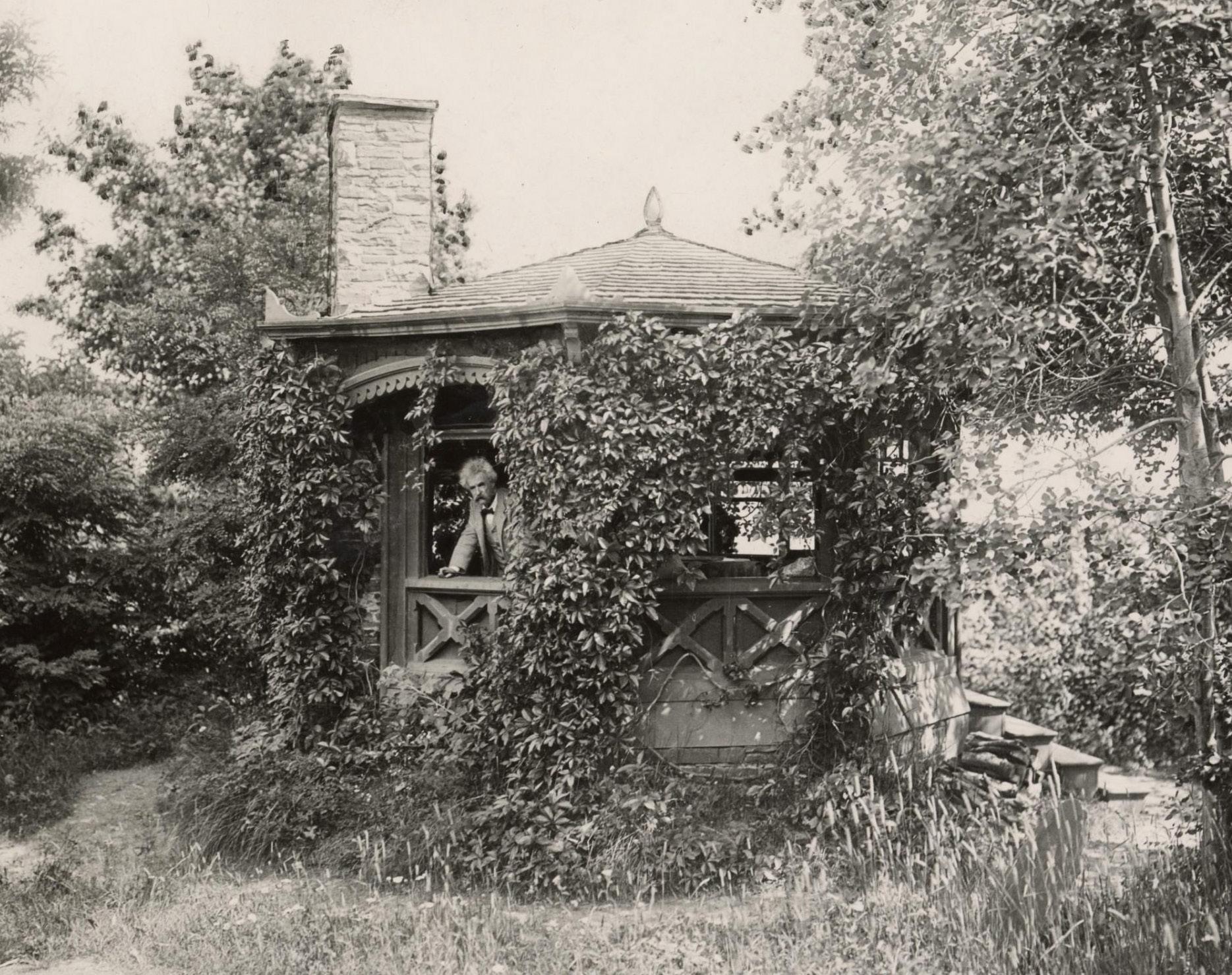
Chemung Canal Trust Company
Community Foundation of Elmira-Corning and the Finger Lakes Corning Inc. Foundation
Renée B. Fisher Foundation
Johnson-Schmidt & Associates
Susan Jaffe Tane
Nancy R. Ruffner ‘63
Georgianna S. Keser
Penny & Kirk Gregg
Gretchen & Tim Sharlow
Carol & Jan Eberhard
Robert McKinnon
Bonnie & Gary Chollet
Franc & Linda Laux
Quarry Farm Foundation
Corporate Sponsors
F.M. Howard Foundation
The Hilliard Foundation
Corning Incorporated Foundation
Community Foundation of Elmira-Corning and the Finger Lakes
Contact Joseph Lemak, jlemak@elmira.edu
34
Interested in becoming a Steward of Quarry Farm?
Directors’ Circle
($1,000 and above)
Arie J. van den Blink, Elmira, NY
Chemung Canal Trust Company
Ronald Chernow, Brooklyn, NY
Bonnie & Gary Chollet, Elmira, NY
Corning Incorporated Foundation
Holbrook Family Trust
Elise Johnson-Schmidt, Corning, NY
Georgianna S. Keser, Elmira, NY
Franc and Linda Laux, Elmira, NY
Mark Twain Foundation
Bruce Michelson, Urbana, Illinois
David Pennock, Townshend, VT
Preservation League of New York State
Renee B. Fisher Foundation
Nancy R. Ruffner ’63, Chappaqua, NY
Gretchen & Tim Sharlow, Jeckyll Island, GA
Susan Jaffe Tane, Westport, CT
Matthew C. Uzzle, Piermont, NY
JoAnn C. Youngman, Milwaukee, WI
CMTS Benefactors
($250-$999)
John R. Alexander, Elmira, NY
Elizabeth F. Bliss, Aurora, OH
Stephen Duprey, Concord, NH
Dennis Eddings, Salem, OR
Elmira Savings Bank
Shelley Fisher Fishkin
Ray G. Gibson, Bath, NY
Charles H. Gold, Chicago, IL
Susan K. Harris, Brooklyn, NY
Cindy K. Hayden, Elmira, NY
James Johnson, Ahoskie, NC IBM
J. Carol Lincoln, Horseheads, NY
David Passmore, Gillett, PA
Valicenti Advisory Services
CMTS Patrons ($100-$249)
James D. Alt, Edina, MN
Anonymous
Theodore W. Arnold, Hawthorne, FL
Richard Benyo, Forestville, CA
David Bianculli, Cherry Hill, NJ
Mary F. Fountain Blakeslee, Erie, PA
John D. Boedicker, Elmira, NY
J.S. Booth, Pine City, NY
Besty A. Bowden, Philadelphia, PA
John H. Chotkowski, Elmira, NY
Angelo Cifaldi, North Haledon, NJ
Marvin M. Cole, Candler, NC
Jane Cummings, Elmira, NY
Susan J. Cummings, Ithaca, NY
Thomas P. Cunningham, Elmira, NY
Kerry Driscoll, West Hartford, CT
Jacqueline A. Droleski, Elmira, NY
Carol & Jan Eberhard, Elmira, NY
Henry A. Feldman, Newtonville, MA
Shawn E. Hast, Rome, NY
Joy R. Hoffman, Horseheads, NY
Donna Homuth, Elmira, NY
Robert L. Johnson, Van Etten, NY
Daniel P. Kane, Elmira, NY
Ivan P. Kane, Wheaton, IL
Dennis Kelly, San Francisco, CA
Holger Kersten, Hildesheim, Germany
Harold H. Kolb, Covesville, VA
Judith Yaross Lee, Durham, NC
William Linn, Lakewood, CA
Kevin Mac Donnell, Austin, TX
Jo Ann Miller, Moorehead, NJ
Carol J. Negri, Elmira, NY
Nancy O’Laughlin, Big Flats, NY
L. Terry Oggel, Richmond, VA
Jeanne Campbell Reesman, San Antonio, TX
Sheryl G. Robinson, Horseheads, NY
Chad Rohman, Elmhurst, IL
John Pascal, West Caldwell, NJ
Matthew C. Perry, Elmira, NY
Laura Rice, Endicott, NY
Ann M. Savage, Elmira, NY
Edward A. Shannon, Warwick, NY
Janeen Sheehe, Elmira, NY
Robert E. Stewart, Carson City, NV
Margaret B. Streeter, Elmira, NY
Suzanne C. Urban, Waverly, NY
John Vallance, Santa Monica, CA
Harry Wonham, Eugene, OR
CMTS Supporters ($25-$99)
Elizabeth F. Barenthaler, Elmira, NY
Ruth L. Bruning, Elmira, NY
Carolyn Bossard, Elmira, NY
Ann R. Cady, Elmira, NY
Diane H. Campbell, De Ruyter, NY
Mary S. Chapman, Lawrence, KS
Clearwater Publishing Company
Thomas B. Copeland, St. Paul, MN
Douglas L. Cotton, Horseheads, NY
James M. Curyk, Simpson, PA
Sarah B. Daugherty, San Jose, CA
Lulu B. Gmoser, Bronxville, NY
Martha Grinnell, Horseheads, NY
Thomas J. Hall, Elmira, NY
James E. Hare, Elmira, NY
Natalie Hill
Alan C. Hutchinson, Horseheads, NY
Dorothy A. Jones, Chesterton, IN
Gary Keister, Goshen, IN
Jan Kinch, Edinboro, PA
Lucius M. Lampton, Magnolia, MS
Joan V. Lindquist, Jackson, NJ
Richard A. Lowenstein, Westport, CT
R. Hugh H. McCarthy, Milford, DE
Gerald McLaughlin, Elmira, NY
Martha P. Pierce, Elmira, NY
Kenneth G. Poetzl, Houston, TX
Judith L. Prentice, Elmira, NY
James A. Rapp, Quincy, IL
Samuel Ricco, Kent, OH
Douglas E. Riley, Tunnelton, WV
Pieter Roos, West Simsbury, CT
Robert Schmieder, Lewisburg, PA
Charlotte Scott, Elmira, NY
David Sloane, Hamden, CT
Stanley F. Stefanski, Pine Valley, NY
Deanne L. Vandevert, Grants Pass, OR
Kay Viney, Addison, TX
Holly A. Young, New York, NY
Thomas Zlatic, St. Louis, MO
SUPPORT CMTS TODAY
35
Left: Mark Twain looking out of the Study at Quarry Farm, 1903
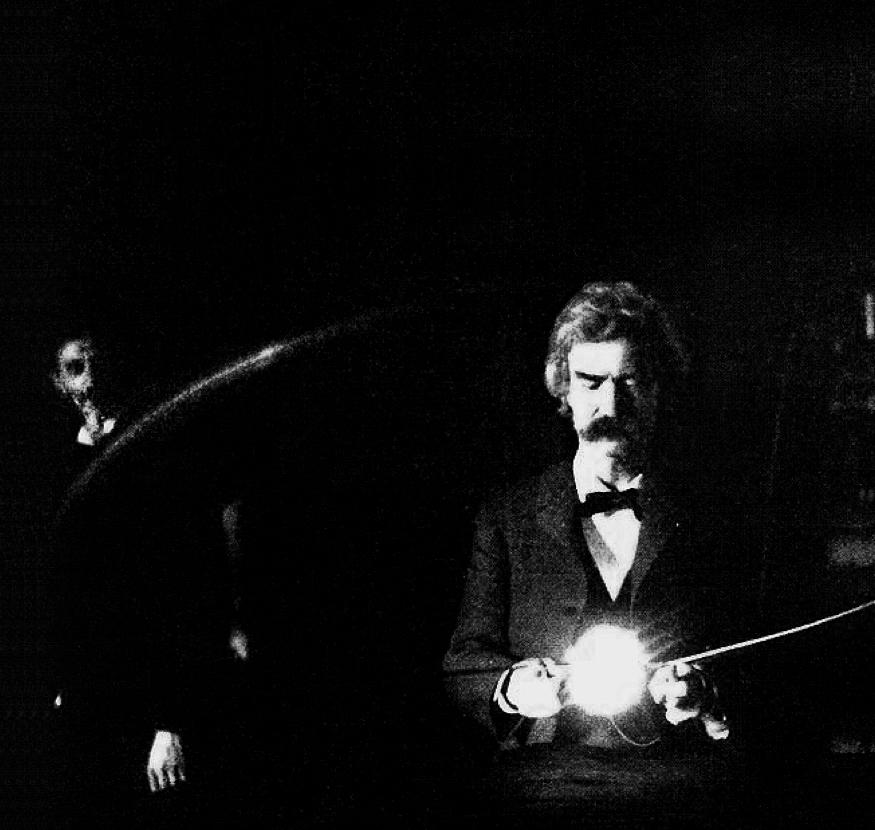
36
Mark Twain in Nikola Tesla’s laboratory in 1894
2023 Quarry Farm Symposium
Mark Twain: Invention, Technology, and Science Fiction
October 6-8, 2023 Elmira, NY
The Center for Mark Twain Studies at Elmira College is hosting its annual Quarry Farm Symposium during the Fall 2023 semester, from Friday, October 6, to Sunday, October 8, 2023, organized around the theme of Mark Twain: Invention, Technology, and Science Fiction.
The year’s Keynote Address will be presented by Sheila Williams, the multiple Hugo award-winning editor of Asimov’s Science Fiction magazine. The annual symposium gathers scholars from various fields around a theme related to Mark Twain studies or the nineteenth-century more broadly and is held at the historic Quarry Farm site, where Twain wrote his most famous works during summer stays with his wife’s family in Elmira, New York.
In his landmark 2010 essay, “On Defining SF, or Not: Genre Theory, SF, and History,” John Rieder wrestles with the slippery definition of “science fiction.” He notes that clear genre definitions are frequently demanded by “two institutional locations, commercial publishing and the academy, and this pair of institutions bears no accidental resemblance to the oppositions between high and low culture....” (204). Building from Bourdieu and Habermas, Rieder argues that because of these “contradictory drives for economic profit and cultural prestige in commercial publishing, the history of sf is well positioned to contribute importantly to broader cultural history...” (206).
Scholars have acknowledged that much of Twain’s work could be labeled “science fiction” if it were published today, an understanding that goes back at least as far as David Ketterer’s 1984 collection, The Science Fiction of Mark Twain. Twain’s writing appeared in the nineteenth-century literary marketplace side-by-side with dime novels about boy explorers in submarines or airships, hero-worshipping biographies of famous inventors, and the translated works of contemporaries like Jules Verne. Moreover, Twain embodies the straddling of popular success and cultural prestige that Rieder mentions; then and now, Twain’s career navigated these contradictions. Locating when and how Twain’s work fits the “science fiction” label can help us see the limits and utility of genre.
Of course, Twain is more than just a literary figure; he was part of a culture immersed in science and technology. Alan Gribben, in Mark Twain’s Literary Resources, Vol. 1 (2019), specifically notes science was one area Twain read voraciously, including “an entire set of Charles Darwin’s works” and “at least a dozen titles” on astronomy (44). Once he had money, Twain constantly sought new inventions to fund; his investments in new printing technology partly caused his bankruptcy. Gary Scharnhorst’s recent biography The Life of Mark Twain: The Final Years (2022) reminds us that Twain spent his later years scrutinizing osteopathy, Christian science, and other nascent medical movements, partly to help his ailing wife and daughters. Twain constantly interacted with all these developing fields and more, frequently in very public, mercurial ways.
With all this in mind, this symposium will work to understand the “broader cultural history” Rieder mentions by placing Twain and his contemporaries within the cultural transformations of science and technology, and within the broad literary boundaries of science fiction. What do we learn if we look at science fiction through the lens of Mark Twain, or Mark Twain through the lens of science fiction? We welcome a range of papers on this theme, including any of the following topics and more:
• Portrayals of science and technology in fiction by Mark Twain and/or his contemporaries
• Scientific and pseudo-scientific ideas that influenced literature during Twain’s lifetime (1835-1910)
• Critical interrogations of nineteenth-century scientific rhetoric, knowledge-making, and science-related art and letters
• Critical examinations of the writing surrounding nineteenth-century invention and science, including patents, copyrights, planning documents, promotional materials, and more
• Research on inventors in Twain’s circle of acquaintances, including James Paige, Nikola Tesla, Jan Szczepanik, or larger concerns such as
• Hartford’s Colt Arms Factory, and their portrayals by Twain or by other writers in “heroic” biographies, magazine features, etc.
• Science fiction in nineteenth-century humor, including frontier narratives, tall tales, scientific romances, and satires
• Twain’s place in the evolving definition of science fiction, including perceptions of him among writers of the Gernsback era, the “Golden Age,” the New Wave, Afrofuturists, and other movements
• Modern technologies and their role in reproducing Twain in online editions, in memes, in repurposed quotations on Facebook, et al.
• Studies of appropriations of Twain’s image or work in science fiction, including steampunk, space opera, or other sub-genres
Please send 300-word abstracts and either a CV or biographical statement, preferably in PDF format, to Nathaniel Williams (ntlwilliams@ucdavis.edu) by February 10, 2023.
37 CaLL
FOR Papers
Now Accepting Applications
QUARRY FARM FELLOWSHIPS
Quarry Farm Fellowships are open to any scholar working in any field related to Mark Twain Studies at any career stage. This is a unique opportunity to work on academic or creative projects at Quarry Farm, Mark Twain’s summer retreat where he penned Adventures of Huckleberry Finn and other iconic works.

Ten Quarry Farm Fellowships will be offered in 2024:
• Ten two-week residencies, including housing at Quarry Farm and a $1000 honorarium for each residency

• At least three fellowships will be reserved for graduate students, contingent faculty, and faculty three or fewer years removed from completion of their Ph.D. or M.F.A
• At least one fellowship will be reserved for writers working on creative projects
• At least one fellowship will be reserved for artists working in the field of visual arts
Applications are due November 30, 2023
Visit MarkTwainStudies.org for more information
38
CLEMENS & THE PEN
Community Arts of Elmira Program at Quarry Farm

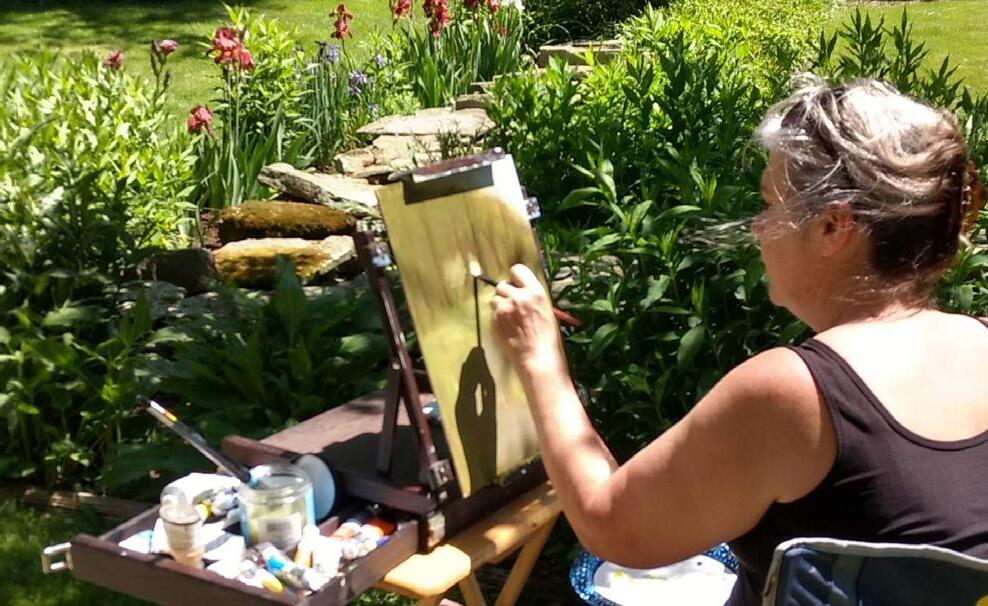
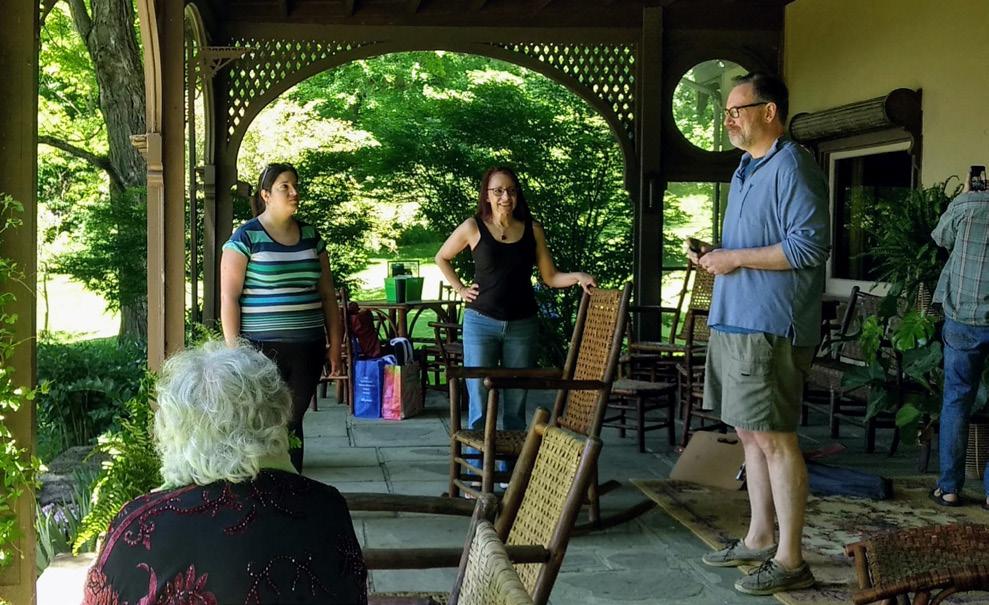
Nine area artists spent an afternoon creating at Quarry Farm through Clemens & the Pen, a program directed by Community Arts of Elmira. The annual ‘porch session’ allows selected artists to participate in a self-directed studio session in their individual artistic disiplines. 2022 was Clemens & The Pen’s fourth year and was marked by an exhibition in CAE’s Pryzgoda Gallery and a display at Elmira College’s Gannett-Tripp Library that was on view during the 2022 Quadrennial Conference.

39
Mountain Day has an annual tradition since 1918. Read More about this Elmira College’s Mountain Day.


Mountain Day 2022, classes were cancelled so students, faculty and staff could enjoy morning activities on campus, a picnic lunch , then run or hike East Hill to Quarry Farm.
 Mark Twain’s study is open to visitors Memorial Day - Labor Day, 10:00AM - 4:30PM / closed for Elmira College holidays.
Mark Twain’s study is open to visitors Memorial Day - Labor Day, 10:00AM - 4:30PM / closed for Elmira College holidays.
WWW.MARKTWAINSTUDIES.ORG






 Carina Gibbs ‘23
Joseph Lemak Director
Carina Gibbs ‘23
Joseph Lemak Director




















 Below:
Below:





























 Mark Twain’s study is open to visitors Memorial Day - Labor Day, 10:00AM - 4:30PM / closed for Elmira College holidays.
Mark Twain’s study is open to visitors Memorial Day - Labor Day, 10:00AM - 4:30PM / closed for Elmira College holidays.




